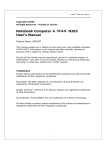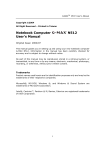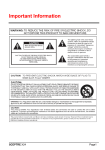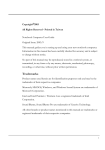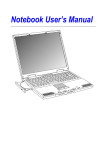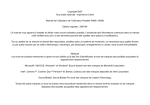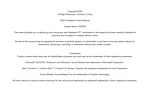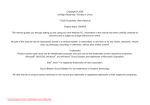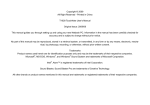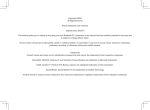Download Notebook Computer N501 User`s Manual
Transcript
G-MAX TM N501 User’s Manual Copyright ©2004 All Right Reserved – Printed in Taiwan Notebook Computer User’s Manual N501 Original Issue: 2004/07 This manual guides you in setting up and using your new notebook computer G-MAX N501. Information in the manual has been carefully checked for accuracy and is subject to change without notice. No part of this manual may be reproduced, stored in a retrieval system, or transmitted, in any form or by any means, electronic, mechanical, photocopy, recording, or otherwise, without prior written consent. Trademarks Product names used herein are for identification purposes only and may be the trademarks of their respective companies. Microsoft®, MS-DOS, Windows ®, and Windows ® Sound System are trademarks of Microsoft Corporation. Intel®, Centrino™, Pentium ® M, Banias, Calexico, Dothan are registered trademarks of Intel Corporation. I TM G-MAX N501 User’s Manual Safety Instructions Use the following safety guidelines to help protect yourself and your notebook. When Using Your Notebook CAUTION: Do not operate your portable computer for an extended period of time with the base resting directly on your body. With extended operation, heat can potentially build up in the base. Allowing sustained contact with the skin could cause discomfort or, eventually, a burn. Do not attempt to service the notebook yourself. Always follow installation instructions closely. Do not carry a battery in your pocket, purse, or other container where metal objects (such as car keys) could short-circuit the battery terminals. The resulting excessive current flow can cause extremely high temperatures and may result in damage from burns. Be sure that nothing rests on your AC adapter’s power cable and that the cable is not located where it can be tripped over or stepped on. Place the AC adapter in a ventilated area, such as a desktop or on the floor, when you use it to run the computer or to charge the battery. Do not cover the AC adapter with papers or other items that will reduce cooling; also, do not use the AC adapter while it is inside a carrying case. Do not push objects into air vents or openings of your notebook computer. Doing so can cause fire or electric shock by shorting out interior components. Use only the AC adapter and batteries that are approved for use with your notebook. Use of another type of battery or AC adapter may risk fire or explosion. Danger of explosion if battery is incorrectly replaced. Before you connect your notebook to a power source, ensure that the voltage rating of the AC adapter matches that of the available power source. 115 V/60 Hz in most of North and South America and some Far Eastern countries such as South Korea and Taiwan. 100 V/50 Hz in eastern Japan and 100 V/60Hz in western Japan. 230 V/50 Hz in most of Europe, the Middle East, and the Far East. If you use an extension cable with your AC adapter, ensure that the total ampere rating of the products plugged in to the extension cable does not exceed the ampere rating of the extension cable. To remove power from your notebook, turn it off, disconnect the AC adapter from the electrical outlet, and remove the battery. To help avoid the potential hazard of electric shock, do not connect or disconnect any cables or perform maintenance or reconfiguration of this product during an electrical storm. Do not dispose of batteries in a fire. They may explode. Check with local authorities for disposal instructions. When setting up your notebook for work, place it on a level surface. When traveling, do not check your notebook as baggage. You can put your notebook through an X-ray security machine, but never put your notebook through a metal detector. If you have your notebook checked by hand, be sure to have a charged battery available in case you are asked to turn on your notebook. When traveling with the hard drive removed from your notebook, wrap the drive in a non-conducting material, such as cloth or paper. If you have the drive checked by hand, be ready to install the drive in your notebook. Your can put the hard drive through an X-ray II G-MAX TM N501 User’s Manual security machine, but never put the drive through a metal detector. When traveling, do not place your notebook in overhead storage compartments where it could slide around. Do not drop your notebook or subject it to other mechanical shocks. Protect your notebook, battery, and hard drive from environmental hazards such as dirt, dust, food, liquids, temperature extremes, and overexposure to sunlight. When you move your notebook between environments with very different temperature and/or humidity ranges, condensation may form on or within your notebook. To avoid damaging your notebook, allow sufficient time for the moisture to evaporate before using your notebook. NOTICE: When taking your notebook from low-temperature conditions into a warmer environment or from high-temperature conditions into a cooler environment, allow your notebook to acclimate to room temperature before turning on power. When you disconnect a cable, pull on its connector or on its strain relief loop, not on the cable itself. As you pull out the connector, keep it evenly aligned to avoid bending any connector pins. Also, before you connect a cable make sure both connectors are correctly oriented and aligned. Before you clean your notebook, turn it off, unplug it from its power source, and remove the battery. Handle components with care. Hold a component such as a memory module by its edges, not its pins. CAUTION: When using your telephone equipment, basic safety precautions should always be followed to reduce the risk of fire, electric shock and injury to persons, including the following: Do not use this product near water, for example, near a bathtub, washing bowl, kitchen sink or laundry tub, in a wet basement or near a swimming pool. Avoid using a telephone (other than a cordless type) during an electrical storm. There may be a remote risk of electric shock from lightning. Do not use the telephone to report a gas leak in the vicinity of the leak. Use only the power cord indicated in this manual. WARNING: Possible voiding of Warranty • • • If the battery is not properly handled, there may be a risk of explosion; make sure you are using the same or equivalent battery. Please dispose the used battery according to the instructions given by the manufacturer. Please be aware that cracked, deeply scratched or other poor quality disk used in this drive may cause damage to the drive and data in the disk. Such discs may break at high-speed rotation. If full care is not exercised in relation to this matter you may void the warranty to this product. III TM G-MAX N501 User’s Manual Regulatory Notices Federal Communications Commission Notice This equipment has been tested and found to comply with the limits for a Class B digital device, pursuant to Part 15 of the FCC rules. These limits are designed to provide reasonable protection against harmful interference in a residential installation. Any changes or modifications made to this equipment may void the user's authority to operate this equipment. This equipment generates, uses, and can radiate radio frequency energy. If not installed and used in accordance with the instructions, may cause harmful interference to radio communications. However, there is no guarantee that interference will not occur in a particular installation. If this equipment does cause harmful interference to radio or television reception, which can be determined by turning the equipment off and on, the user is encouraged to try to correct the interference by one or more of the following measures: Reorient or relocate the receiving antenna. Increase the separation between the equipment and receiver. Connect the equipment into an outlet on a circuit different from that to which the receiver is connected. Consult the dealer or an experienced radio/TV technician for help. All external cables connecting to this basic unit must be shielded. For cables connecting to PC cards, see the option manual or installation instructions. Modifications The FCC requires the user to be notified that any changes or modifications made to this device that are not expressly approved by the manufacturer responsible for compliance may void the user’s authority to operate the equipment. Cables Connections to this device must be made with shielded cables with metallic RFI/EMI connector hoods to maintain compliance with FCC Rules and Regulations. Federal Communications Commission (FCC) PART 68 Warning This equipment complies with Part 68 of the FCC Rules. On the bottom of the computer is a label that contains, among other information, the FCC Registration Number and Ringer Equivalence Number (REN) for this equipment. You must, upon request, provide this information to your telephone company. FCC Part 68 Registration Number: 6CTTAI - 25876 - FB – E REN: 0.8B The REN is useful to determine the quantity of devices you may connect to your telephone and still have those devices ring when your number is called. In most, but not all areas, the sum of the REN's of all devices should not exceed five (5.0). To be certain of the number of devices you may connect to your line, as determined by the REN, you should call your local telephone company to determine the maximum REN for your calling area. IV G-MAX TM N501 User’s Manual If your MODEM causes harm to the telephone network, the local Telephone Company may discontinue your service temporarily. If possible, they will notify you in advance. However, if advanced notice isn't practical, you will be notified as soon as possible. You will be informed of your right to file a complaint with the FCC. Your telephone company may make changes in its facilities, equipment, operations, or procedures that could affect the proper functioning for your equipment. If they do, you will be notified in advance to give you an opportunity to maintain an uninterrupted telephone service. CE Notice (European Union) indicates compliance of notebook computer G-MAX N501 to the Marking by the symbol EMC Directive and the Low Voltage Directive of the European Union. Such marking indicates that this notebook computer G-MAX N501 system meets the following technical standards: EN 55022 — "Limits and Methods of Measurement of Radio Interference Characteristics of Information Technology Equipment." EN 55024 — "Information technology equipment - Immunity characteristics - Limits and methods of measurement." EN 61000-3-2 — "Electromagnetic compatibility (EMC) - Part 3: Limits - Section 2: Limits for harmonic current emissions (Equipment input current up to and including 16 A per phase)." EN 61000-3-3 — "Electromagnetic compatibility (EMC) - Part 3: Limits - Section 3: Limitation of voltage fluctuations and flicker in low-voltage supply systems for equipment with rated current up to and including 16 A." EN 60950 — "Safety of Information Technology Equipment." NOTE: EN 55022 emissions requirements provide for two classifications: Class A is for typical commercial areas. Class B is for typical domestic areas. To determine which classification applies to your notebook, examine the FCC registration label located on the back panel of your notebook. If the label indicates a Class A rating, the following warning applies to your notebook: RF INTERFERENCE WARNING: This is a Class A product. In a domestic environment this product may cause radio frequency (RF) interference, in which case the user may be required to take adequate measures. This notebook computer G-MAX N501 device is classified for use in a typical Class B domestic environment. A "Declaration of Conformity" in accordance with the preceding directives and standards has been made and is on file at Gigabyte Computer Corporation. CCC Notice (China Only) On Class A systems, the following warning will appear near the regulatory label: V TM G-MAX N501 User’s Manual Warning: This is a Class A product. In a domestic environment this product may cause radio interference, in which case the user may be required to take adequate measures. BSMI Notice (Taiwan Only) Most notebook computer G-MAX N501 products are classified by the Bureau of Standards, Meteorology and Inspection (BSMI) as Class B information technology equipment (ITE). This notebook computer G-MAX N501 device is classified for use in a typical Class B domestic environment. CANADIAN DOC NOTICE This digital apparatus does not exceed the Class B limits for radio noise emissions from digital apparatus as set out in the Radio Interference Regulation of the Canadian Department of Communications. "Le présent appareil numérique n'èmet pas de bruits radioélectriques dépassant les limites applicables aux appareils numériques de la class B prescrites dans le Règlement sur le brouillage radioélectrique édicté par le ministère des Communications du Canada". Macrovision License of Notice This product incorporates copyright protection technology that is protected by methods and claims of certain U.S. patents and other intellectual rights owned by Macrovision Corporation, and other rights owners. Use of this copyright protection technology must be authorized by Macrovision Corporation and is intended for home and other limited viewing uses only unless authorized by Macrovision Corporation. Reverse engineering of disassembly is prohibited. VI G-MAX About Your Notebook G-MAX N501 TM N501 User’s Manual Computer Congratulation for having purchased your new All-In-One Notebook Computer G-MAX N501. Your notebook computer G-MAX N501 incorporates the remarkable performance and flexible connectivity, to give you a fine-tuned set of computing tools for reasonable price. Your new notebook computer G-MAX N501 is dedicated to professional elite who demands excellent efficiency like you. VII TM G-MAX N501 User’s Manual VIII G-MAX TM N501 User’s Manual About This User’s Manual Welcome to your All-In-One Notebook Computer G-MAX N501 User’s Manual. This manual covers everything you need to know in learning how to use your notebook computer G-MAX N501. This manual also assumes that you know the basic concepts of Windows and the PC. You will start doing a lot of great and fun things with your notebook computer G-MAX N501. This manual is divided into eight chapters: Chapter 1 introduces you to the features of your notebook computer G-MAX N501. Chapter 2 gives you useful details on using your notebook computer G-MAX N501. Chapter 3 tells you how to look after your notebook computer G-MAX N501. Chapter 4 talks about PC Card peripherals and how to use them. Chapter 5 goes into more detail about power management and explains how to conserve power while on the move. Chapter 6 introduces you to BIOS, how to recover your system, and how to change its fundamental settings. Chapter 7 gives you tips on solving typical problems you may run up against. Chapter 8 instructs you on how to deal with common system problems. IX TM G-MAX N501 User’s Manual There is no need to read the manual from the beginning to end. Simply find your way to the section that interests you using the index, or browse through the manual. You will come across the following icons in the manual: Helpful pointers and tricks to get more from your notebook computer G-MAX N501 To help you note and avoid possible damage to your notebook computer G-MAX N501's hardware or software, or loss of your work Points out possible damage to property, personal injury or death X Contents Safety Instructions……….………………………………………………… Ⅱ Regulatory Notices…………………………………………………………..Ⅳ About Your Notebook Computer G-MAX N501……………………. Ⅶ About This User’s Manual………………………………………………….Ⅸ 1 Introducing Your Notebook Computer G-MAX N501…………3 1.1 Front Side………………….…………………….……………………………………4 1.2 Right Side ...............................…………………….……………………8 1.3 LeftSide ……………………………………………..………………………………. 10 1.4 Back Side………………………..……………………………………………………12 1.5 Bottom Side………………………………………………………………………….14 2 3 Operating Your Notebook Computer G-MAX N501…………17 2.1 Turning Your Notebook Computer G-MAX N501 On/ Off…….18 2.2 2.3 Keyboard and TouchPad……............................................21 Configuring Your Screen Display………………………………………….26 Care and Maintenance ………………………………………………29 3.1 Taking Care of Your Notebook Computer G-MAX N501……..30 Taking Care of Your AC Adapter…………………………………………..30 Taking Care of Your Battery Pack...….…………………………………31 4 3.2 Clean and Serving……………………………………………………………….32 3.3 Maintaining the LCD Quality………………………………………………..32 3.4 3.5 Maintaining Your Hard Disk………………………………………………….32 When You Travel…………………………………………………………………..33 Peripherals……………………………………………………………….35 4.1 PC Cards……………………………………………………………………………….36 4.2 Adding and Removing SD Cards………………………………………….38 4.3 Printers………………………………………………………………………………….38 4.4 5 Memory Modules…………………………………………………………………. 39 The Power System…………………………………………………….41 5.1 Power Management……………………………………………………………..42 5.2 Battery………………………………………………………………………………….44 6 Setting / BIOS………………………………………………………....49 6.1 Using the Express Recovery Utility………………………………......50 6.2 Running the BIOS Setup Program……………………………………....51 1 TM G-MAX N501 User’s Manual 6.3 The Main Menu.....……………………………………………………… 6.4 The System Devices Menu…………………………………………………..54 6.5 The Security Menu………………………………………………………………. 57 6.6 The Boot Menu……………………………………………………………………..58 6.7 The Exit Menu……………………………………………………………………….59 6.8 How to Upgrade the BIOS..…………………………………………………..62 7 Troubleshooting……………………………………………………..…65 7.1 Frequently Asked Questions……….……………………………………….66 8 Specifications……………………………………………………………69 Appendix A World Wide Service…………………………………………..……….73 World Wide Service Locations List…………………………………………………..74 2 G-MAX 1 TM N501 User’s Manual Introducing your notebook computer G-MAX N501 Your notebook computer G-MAX N501 is a fully Windows compatible portable personal computer. With the these powerful features in mobile computing, your notebook computer G-MAX N501 makes a natural high-performance companion. With leap of technology and compact, your notebook computer G-MAX N501 runs on a whole wide range of general business, personal productivity, entertainment, and professional applications. It is ideal for use in the office, at home, and on the road. Your notebook computer G-MAX N501 makes an ideal choice for use in the office, the schoolroom, at home, on the road and all other occasions. 3 TM G-MAX N501 User’s Manual 1.1 Front 1 2 9 3 10 8 4 5 6 7 1 LCD Module Latch 6 Device Status Lights 2 Display 7 Optical Digital Drive 3 Easy Buttons 8 Keyboard 4 TouchPad 9 Power Button 5 TouchPad Button 10 4 Keyboard Status Lights G-MAX TM N501 User’s Manual 1.1.1 LCD Module Latch Secures the display case to your notebook computer G-MAX N501. To open the display, slide the latch to the right and lift the display. When you close the display, the latch will secure it automatically. 1.1.2 Display Your display is a 15” / 14.1” COLOR TFT/XGA + LCD. 1.1.3 Easy Buttons These 2 buttons launch your favorite programs. Launches a pre-configured program. 1.1.4 TouchPad The TouchPad works like a desktop mouse. For more information see Keyboard and TouchPad in Chapter 2. 1.1.5 TouchPad Buttons The left and right TouchPad buttons work like the left/right buttons on a standard mouse. 5 TM G-MAX N501 User’s Manual 1.1.6 Device Status Lights Indicates power on; flashing indicates standby mode. Indicates battery status. For details, see Battery. Indicates wireless communication status. 1.1.7 Optical Digital Drive The optical digital drive provides a means for you to import/export data and small files into/from your notebook computer G-MAX N501. Depending on the configuration of your notebook computer G-MAX N501, you may either be able to record CDs or play DVDs. To remove the Optical Digital Drive: 1. Slide the ODD Module Latch to the left. 2. Gently pull the ODD from the ODD Module Bay. 6 G-MAX 1.1.8 TM N501 User’s Manual Keyboard The keyboard includes a numeric keypad and the Microsoft® Windows® logo key . See Keyboard and TouchPad in Chapter 2 for more on using keyboard shortcuts. 1.1.9 Power Button Press to turn your notebook computer G-MAX N501 on. For more on power settings, see Power Management. Windows XP, which comes preinstalled, goes into the shutdown sequence automatically if you press the power button while on. You can configure this in Control Panel: Power Options – Advanced. 1.1.10 Keyboard Status Lights Indicates uppercase letter function enabled Indicates numeric keypad enabled Indicates PadLock enabled 7 TM G-MAX 1.2 N501 User’s Manual Right Side 1 Speaker 2 AC Adapter connector 3 Air Vent 1.2.1 Speaker To adjust the system speaker volume, look under the Sounds and Audio Devices Properties of the Control Panel. Refer to Windows ® manual for more details. Many software programs, such as multimedia applications, also include their own volume controls. 8 G-MAX TM N501 User’s Manual 1.2.2 AC Adapter Connector Use this connector to attach the AC adapter to your notebook computer G-MAX N501. You can connect an AC adapter when your notebook computer G-MAX N501 is switched on or off. While the AC adapter works with electrical outlets worldwide, power connectors and power strips vary from country to country. Ensure you use compatible cable or correctly connect the cable to the power strip or electrical outlet. Failure to do so may cause fire or damage to equipment. 1.2.3 Air Vent An internal fan creates airflow through the vents, preventing your notebook computer G-MAX N501 from overheating. When it gets hot, your notebook computer G-MAX N501 will switch on the fans, which may make some noise. This is normal, and does not mean there is a problem. Never block, push objects into, or allow dust to gather in the air vents. Doing so may damage your notebook or cause a fire. 9 TM G-MAX 1.3 N501 User’s Manual Left Side 1 USB Connector 2 Infrared Port 3 PC Card Port 4 SD Card Port 5 Audio Ports 6 Wireless Communication Switch 7 Speaker 1.3.1 USB Connector Use this port to connect a USB device, such as a mouse, full-size external keyboard, or printer, to the notebook computer G-MAX N501. USB is a peripheral expansion standard that supports a data-transfer rate of up to 480 Mbps. USB peripherals have a single standard for cables and connectors. You can install and remove USB devices while the computer is on. This is known as "hot swapping". 10 G-MAX 1.3.2 TM N501 User’s Manual Infrared Port Use this port to send and receive infrared (IR) signals to and from other IR-compatible devices. Supports a transfer rate of up to 4 Mbps per second. 1.3.3 PC Card Port Supports one type II PC Cards. For more information, see in Chapter 4. 1.3.4 SD Card Port Supports one Secure Digital card, which is used in digital still camera and various forms of portable information equipment. 1.3.5 Audio Ports You can connect a headphone or an external speaker to the port and a microphone to the port. The built-in speakers are disabled when a device is connected to the port. 1.3.6 Wireless Communication Switch Turns the wireless communication LED activated. 1.3.7 communication function on or off. The wireless on the front panel lights when the function is Speaker To adjust the system speaker volume, look under the Sounds and Audio Devices Properties of the Control Panel. Refer to Windows ® manual for more details. Many software programs, such as multimedia applications, also include their own volume controls. 11 TM G-MAX N501 User’s Manual 1.4 Back 1 Security Cable Connector 5 Modem Jack 2 Parallel Port 6 Network Jack 3 External Monitor Port 7 TV-out Port 4 USB Ports x 2 8 IEEE 1394 Port 1.4.1 Security Cable Connector To protect your notebook computer G-MAX N501 from theft, you can purchase an antitheft device. Instructions for use are included with such devices. Before purchasing any antitheft device, check that it will work with your notebook's security cable connector. 1.4.2 Parallel Port Use this port to connect parallel devices, such as a printer. To protect your notebook computer G-MAX N501, wait 5 seconds after turning it off before disconnecting any external device. 1.4.3 External Monitor Port Use this port to connect an external monitor to your notebook computer G-MAX N501. See Configuring Your Screen Display, Chapter 2-3. 12 G-MAX 1.4.4 TM N501 User’s Manual USB Connectors Use these ports to connect up to three USB devices, such as a mouse, full-size external keyboard, or printer. USB is a peripheral expansion standard, and this standard is united for cables and connectors. You can install and remove USB devices while the computer is on. This is known as "hot swapping”. 1.4.5 Modem Jack The modem jack allows you to connect your notebook computer G-MAX N501 to a telephone line with a standard RJ-11 connector. Never connect the modem jack to a digital line. The high current of a digital line could damage the modem. 1.4.6 Network Jack The RJ-45 network jack allows you to connect your notebook computer G-MAX N501 to a local area network (LAN). Be careful not to plug the telephone line into the slightly larger network connector. 1.4.7 TV-out Port Use this port to connect a television set. See Chapter 2-3 “Configuring Your Screen Display” for more details. 1.4.8 IEEE 1394 Port The IEEE 1394 port allows you to connect devices that utilize IEEE 1394 technology to your computer. This technology is widely used in consumer products such as digital cameras. 13 TM G-MAX 1.5 N501 User’s Manual Bottom 1 Battery Release Latch 4 Memory Module Cover 2 Battery Pack 5 ODD Module Release Latch 3 HDD 1.5.1 Battery Release Latch The battery release latch secures the battery pack. To release, simply slide the latch across. The battery pack will pop up. 1.5.2 Battery Pack With a charged battery pack installed, you can use your notebook computer G-MAX N501 without connecting it to an electrical outlet. For more details, see Battery, Chapter 5. To remove the battery pack: 1. Slide the Battery Pack Release Latch to the left. 2. Gently pry the Battery Pack from the computer chassis. 14 G-MAX 1.5.3 TM N501 User’s Manual HDD The HDD should only be removed if you need to repair or replace the installed HDD unit. To remove the HDD: 1. Remove the screw securing the HDD to the chassis 2. Gently pull the HDD out. Do not replace the HDD on your own! If the HDD requires replacing, take your notebook computer G-MAX N501 to your dealer or a service technician. 1.5.4 Memory Module Cover The memory module(s) is (are) housed beneath the memory module cover. 1.5.5 ODD Module Release Latch This releases the optical digital drive (ODD). Slide it to the left and then carefully pull the ODD from its bay. 15 TM G-MAX N501 User’s Manual 16 G-MAX 2 TM N501 User’s Manual Operating Your Notebook Computer G-MAX N501 Your notebook computer G-MAX N501 is designed and pre-configured for easy setup and use. This chapter describes the installation steps you should follow to get your notebook computer G-MAX N501 up and running as quickly as possible. Contact your dealer if they have pre-installed all the needed drivers to fully operate your notebook computer G-MAX N501 or if there is an update on the driver installation of your notebook computer G-MAX N501. 17 TM G-MAX 2.1 N501 User’s Manual Turning Your Notebook Computer G-MAX N501 On and Off 2.1.1 Starting Your Notebook Computer G-MAX N501 The Power button is found on the top of the base unit. Press the Power button to start your notebook computer G-MAX N501 and check that if the Power LED turns on. After a few seconds, the notebook’s display will turn on and your notebook computer G-MAX N501 will begin to execute the Power On Self Test or POST to check if all system components are running properly. Any error found during the test will be displayed on the screen and may generate short beep sound as well. After the test, the screen will also display a message "press <F2> to enter SETUP". You don’t need to run this program at the moment as your dealer already made the necessary settings for your notebook computer G-MAX N501 optimal operation. Refer to Chapter 6 on running the SETUP program later. After the test has completed, your notebook computer G-MAX N501 will start to search and boot up the operating system from your hard drive. The notebook computer G-MAX N501 normally comes with a Windows operating system pre-installed in your hard drive. Consult the Windows manual on how to use the program. If not, contact your dealer for assistance. 2.1.2 Adjusting the Display Controls The LCD brightness adjustment is controlled by <Fn> +<↑> and <Fn> + <↓> keys respectively. You need to press these hot-key controls after powering on your N501 to suit your viewing pleasure. The Brightness hot-key control adjusts the brightness on the LCD. The brightness hot-key control will not set the LCD completely dark or bright; it provides sufficient lighting to the LCD to match the external lighting of the surrounding. The brighter the room, the more you need to increase the brightness of the LCD. 18 G-MAX 2.1.3 TM N501 User’s Manual Installing Your Notebook Computer G-MAX N501’s Device Drivers If you already have an operating system installed into your notebook computer G-MAX N501, it is best to install all device drivers that you need by using the built-in devices of your notebook computer G-MAX N501. Before installing the drivers, check with your dealer first if they have already installed all the drivers along with the operating system. If not, follow the procedures below: Installing Windows XP 1. You can find one bundled Driver CD shown as follow. 2. Put the CD into the DVD/CD-RW/DVD Dual Drive. It will get you through the Auto Run installation. 19 TM G-MAX N501 User’s Manual 2.1.4 Turning off Your Notebook Computer G-MAX N501 If you are not going to use your notebook computer G-MAX N501 for a while, it is best to turn off the power of your notebook computer G-MAX N501 for longer use. Before turning off the power, you need to close first all application programs and shutdown the operating system. After turning off your notebook computer G-MAX N501, make it a habit to leave the LCD panel open for a while whenever used for an extended period of time. This allows the inside parts of your notebook computer G-MAX N501 to cool off. Closing the panel will force the heat up against the LCD screen, which may degrade the LCD when done regularly. More importantly, never close the LCD panel for a long period of time when computer is on and power saving features are disabled. 20 G-MAX 2.2 TM N501 User’s Manual Keyboard and TouchPad 2.2.1 Understanding the Keyboard Functions Basic Keyboard Functions Keypad Function Description <Enter> key. Execute a command. Within many text editing application programs, the <Enter> key inserts a hard carriage return, just like what ordinary typewriter does. Enter <Esc> key. Press this key to cancel or escape from a command or function. Esc PrtScr SysRq <PrtSc> key. Known as the Print Screen key. Press this key to map the whole screen to share memory for your specific usage. Pause Break <Pause> key. Press this key to temporarily halt execution of a command. Pressing any other key to resume execution of a command. Pause Break Fn + Ins Del Backspace <Fn>+<Break> key. Press this key to temporarily halt execution of a command. Pressing any other key to resume execution of a command. <Ins> key. Known as the Insert key. Press this key to toggle the keyboard data entry from insert to type over mode. <Del> key. Known as the Delete key. Press this key to delete the character to the right of the cursor, or delete marked texts or items. <Backspace> key. Press this key to delete the character to the left of the cursor. 21 TM G-MAX N501 User’s Manual Keypad <Shift> key. Press this key in combination with alphabet letters to produce uppercase letters in typing. Use this key in combination with those two-character keys (found on the second row of the keyboard) to produce the upper marked keys. Also used in most application program in combination with other keys to execute a certain command. Shift <Tab> key. Press this key to move the cursor to the next tab stop on the right. This key works much the same as in ordinary typewriter. Tab <Ctrl> key. Known as the Control key. Used in most application program in combination with other keys to execute a certain command. Ctrl <Alt> key. Known as the Alternate key. Used in most application program in combination with other keys to execute a certain command. Alt Fn + Caps Lock ScrLk NumLk Function Description ScrLk NumLk <Fn>+<Num Lock> key. Activates the embedded 15-key numeric keypad. The keys are color coded blue. <Caps Lock> key. Used in most application program to always activate uppercase alphabet characters. <Scroll Lock> key. Used in most application program to scroll the screen without having to move the cursor. 22 G-MAX TM N501 User’s Manual Cursor Control Keys Keypad Function Description PgUp Up arrow key. Moves the cursor up one line at a time. PgDn Down arrow key. Moves the cursor down one line at a time. Home Left arrow key. Moves the cursor to the left one space at a time. End Right arrow key. Moves the cursor to the right one space at a time. Screen Control Keys Keypad Home PgUp PgDn End Fn + Fn + Fn + Fn + Function Description <Fn>+<Home> key. Moves the cursor to the beginning of a screen or line. <Fn>+<PgUp> key. Moves the cursor up one screen at a time <Fn>+<PgDn> key. Moves the cursor down one screen at a time <Fn>+<End> key. Moves the cursor to the end of a screen or line. 23 TM G-MAX N501 User’s Manual Windows Hot Keys Keypad Function Description <Start> key. Pulls up the Windows Start menu. Special Function Key Notebook computer G-MAX N501 has special system function keys that activate key serving dual functions. When pressed in conjunction with the <Fn> key, these keys set specific system parameters and are sometimes referred to as "hot keys". Keypad Function Description Switches Display Mode (LCD > CRT > Simultaneous). Switches the video image to the next display in the following sequence: the integrated display, an external monitor, and both displays simultaneously Number Lock Scroll Lock Brightness Up Brightness Down Pad Lock 24 G-MAX TM N501 User’s Manual 2.2.2 TouchPad The TouchPad responds to the movements and pressure of your finger, allowing you to move the cursor around the screen, in the same way you would with a mouse. You can use the TouchPad by moving your finger on the TouchPad. The TouchPad buttons have the same function as mouse buttons. Clicking these buttons makes selections, drags objects, or performs a variety of other functions depending on the software. To select an object, first move the pointer over the object you want to select, and then press the left button one time and release it. The functionality of these buttons depends on your software. Double-clicking is a common technique for selecting objects or launching programs. You may also select object or execute applications from icons by double tapping. This is similar to double-clicking, but instead of pressing the TouchPad buttons, you tap the TouchPad itself. 2.2.2.1 Customizing the TouchPad To adjust TouchPad settings, use the Mouse Properties window, which you can open by clicking Control Panel > Printers and Other Hardware > Mouse. Select the desired settings and click Apply. Click OK to save the settings and close the window. 25 TM G-MAX 2.3 N501 User’s Manual Configuring Your Screen Display The VGA display function of your notebook computer G-MAX N501 is based on a high performance AGP local bus controller. This controller offers a large set of extended functions and higher resolutions especially useful when you are connecting an external high-resolution and high-frequency CRT or LCD. Please refer to Chapter 2-1-3 "Installing Your Notebook Computer G-MAX N501 Device Drivers" for the procedures on how to install the VGA device driver under Windows. After installing the VGA driver, you would then configure the display resolution or screen size to match your LCD display panel. Your notebook computer G-MAX N501 provides 1024x768 panels. You would also probably want to set the amount of color output to display sharper images and photos. 2.3.1 Possible Display Configurations The table below shows you the possible display resolution you can set when using either the LCD display or the external monitor (CRT): Display Possible Resolution Maximum Colors 1024x768 XGA LCD 640x480 800x600 1024x768 16 million colors 16 million colors 16 million colors CRT Only 640x480 800x600 1024x768 1152x768 1280x1024 16 16 16 16 16 26 million million million million million colors colors colors colors colors G-MAX TM N501 User’s Manual 65,536 or 64K colors is also equivalent to 16-bit high color while 16 million or 16M colors is equivalent to 32-bit true color. You can use the <Fn> + <F5> hot-key to switch the display between LCD only, CRT only, or both LCD and CRT display. 2.3.2 Changing the Display Properties under Windows® To change the display properties of your screen under Windows system, just right-click on the desktop area and select Properties or go to the Control Panel and click on the Display icon. The Display Properties dialog box will appear on your screen. Click on the Settings tab to set your desired configuration. Make sure to follow the configuration table above. If you cannot configure the display properties, change the display driver first as mentioned on Chapter 2-1-3 "Installing Your Notebook Computer G-MAX N501 Device Drivers". Consult your dealer for the latest Windows AGP VGA driver. 27 TM G-MAX N501 User’s Manual 28 G-MAX 3 TM N501 User’s Manual Cleaning & Maintenance Your notebook computer G-MAX N501 will serve you well if you take care of it. This chapter describes some tips and notice about how to care and maintain your notebook computer G-MAX N501. 29 TM G-MAX 3.1 N501 User’s Manual Taking Care of Your Notebook Computer G-MAX N501 • The openings on the enclosure are for air convection hence your notebook computer can be protected from overheating. DO NOT COVER THE OPENINGS. • Do not expose your notebook to direct sunlight. Do not place it near sources of heat, such as a radiator. • Do not expose your notebook to temperatures below 5ºC (41ºF) or above 40ºC (104ºF). • Do not subject your notebook to magnetic fields. • Do not expose your notebook to rain or moisture. • Do not spill water or any liquid on your notebook. • Do not subject your notebook to heavy shock and vibration. • Do not expose your notebook to dust and dirt. • Never place objects on top of your notebook to avoid damaging your notebook. • Never place your notebook on uneven surfaces. • Use only a power adapter approved for use with your notebook computer. • If your notebook computer is not in use for a long time, disconnect it from mains to avoid possible damage by transient over-voltage. • Never open the body of your notebook computer. For safety reason, your notebook computer should only be opened by qualified service personnel. Taking Care of Your AC Adapter Here are some ways to take care of your AC adapter: • Do not connect the adapter to any other device. • Do not step on the power cord or place heavy objects on top of it. Carefully route the power cord and any cables away from all potential traffic. 30 G-MAX TM N501 User’s Manual • When unplugging the power cord, do not pull on the cord itself but pull on the plug. • The total ampere ratings of the equipment plugged in should not exceed the ampere rating of the cord if you are using an extension cord. Also, the total current rating of all equipment plugged into a single wall outlet should not exceed the fuse rating. • Make sure the voltage of the power source when connect your notebook computer to the power outlet. If your are unsure of your local power specifications, consult your dealer or local power company. Taking Care of Your Battery Pack Here are some ways to take care of your battery pack: • Use only batteries of the same kind as replacements. Turn the power off before removing or replacing batteries. • Do not tamper with batteries. Keep them away from children. • Handle batteries carefully. Do not try to disassemble, crush, puncture, open, drop, mutilate, short external contacts, disposed of in water or fire, or expose it to temperatures higher than 60 C. • Recharge batteries only as described in this manual and only in ventilated areas. Never use an external charger other than the one supplied with your notebook computer. • Do not leave batteries in hot locations for more than a day or two. • Do not leave your battery in your notebook computer for longer than 1 month without plugging in the power adapter. • Do not leave battery in storage for more than 2 months without recharging it to prevent over discharge. Over discharge will hurt the battery either. • Dispose of used batteries according to local regulations. Recycle if at all possible. 31 TM G-MAX N501 User’s Manual 3.2 Cleaning and Serving When cleaning your notebook, follow these steps: 1. Power off your notebook and remove the battery pack. 2. Disconnect the AC adapter. 3. Use a soft cloth moistened with water. Do not use liquid or aerosol cleaners. 3.3 Maintaining the LCD Quality When it comes to screen problems, heat plays a big part. After a good working session, the typical routine is to shut the machine and close the cover. But the display surface - no matter what type it is - and the components inside the computer radiates heat; when you close the cover, you trap the heat against the screen. Leave your notebook computer G-MAX N501's cover open for about ten minutes while the heat disperses. Make this a habit. You should also enable the power management of your notebook computer G-MAX N501 to turn off the LCD power and display when the system is in inactivity for some time. Adding screen savers is also acceptable. Follow the safety guidelines mentioned earlier and how to clean your notebook computer G-MAX N501. 3.4 Maintaining Your Hard Disk Losing your data has the same consequences as a system break down. Users must make it a habit of doing hard disk maintenance every week or so. Here is some maintenance you could do: • Always backup your data files from your hard disk. • Install the virus detecting program to monitor virus that could tamper your files. • Use SCANDISK once in a while to correct any errors found in the directory and File Allocation Table. This will also free up space from any unused sectors. 32 G-MAX TM N501 User’s Manual • Never move or raise the computer while the hard disk is being accessed, most especially don't jar the hard disk as this may cause a hard disk crash. • Use hard disk maintenance programs like Disk Defragmenter of Windows. These reorganize your hard disk by eliminating fragmentation and improving your hard disk access time. • Install a system password in your computer so others won't be able to use the hard disk. About maintaining data in your hard disk, please refer to p.50 “Using the Xpress Recovery Utility”. 3.5 When You Travel For safety and convenience when traveling, please follow these instructions: • Backup all needed files on your hard disk before traveling. • Recharge your battery overnight to ensure full battery power before you leave. • Don't forget to bring along the AC adapter and extra battery pack. • Try to bring backup software as well. • Check the voltage rating and the outlet type of your destination. If the power cord of the adapter is different, then you need to purchase a suitable one. Consult your dealer. • Carry your notebook computer G-MAX N501 in its carrying case or in a briefcase. Never check-in the computer as a luggage. • Remember to apply those power saving features and techniques to save battery power. Contact your dealer or see your service technician if any of the following occurs: • Your notebook has been dropped or the body has been damaged. • Liquid has been spilled into the product. • Your notebook does not operate normally. 33 TM G-MAX N501 User’s Manual 34 G-MAX 4 TM N501 User’s Manual Peripherals This chapter describes how you attach peripheral devices to your notebook computer G-MAX N501. You can attach a printer or mouse; connect an external monitor and keyboard, or any other peripheral device. You will learn how to use these peripheral devices with the step-by-step instructions depicted in this chapter. 35 TM G-MAX N501 User’s Manual 4.1 PC Cards 4.1.1 PC Card Types The PC Card slot supports one Type II card. It also supports CardBus technology and extended PC Cards. "Type" refers to the card's thickness, not what it does. A PC Card is not a bootable device. 4.1.2 Extended PC Cards An extended PC Card is longer than a standard PC Card. When using extended PC Cards, follow these precautions: λ Try not to hit the exposed end of the installed card. If the end of the card is struck, the system board may be damaged. λ Always remove an extended PC Card before packing your notebook in its carry case. 4.1.3 Installing PC Cards PC Cards may be 'hot-swapped', which means you can install a card while your notebook computer G-MAX N501 is running. The card will be detected automatically by the operating system and ready for use. Usually PC Cards have a mark or symbol to show which end to insert into the slot. Cards are keyed to prevent incorrect insertion. Refer to the PC Card’s literature that comes with your card if the orientation is unclear. 36 G-MAX TM N501 User’s Manual 1. Hold the card with its orientation symbol pointing into the slot and the topside of the card facing up. The push-button latch may need to be in before inserting the card. 2. Slide the card into the slot until it clicks into the connector. 3. If you encounter too much resistance, do not force the card. Check the card orientation and try again. Your notebook computer G-MAX N501 will recognize most PC Cards and automatically load the appropriate device driver. If the configuration program tells you to load the manufacturer's drivers, use the floppy disk or CD that came with the PC Card. 4.1.4 Removing PC Cards Before removing a PC Card, stop it running from the configuration utility on the taskbar. Failure to do so could result in data loss. Never try to remove a PC Card by pulling on its cable, if one is attached. 1. Press the release latch. 2. Press the latch again to eject the card. 3. Remove the card. 37 TM G-MAX 4.2 N501 User’s Manual Adding and Removing SD Cards Before removing a SD Card, stop it running from the configuration utility on the taskbar. Failure to do so could result in data loss. Insert the SD card into the SD Card slot. This is the tiny slot below the PC Card – the two slots are built into the same space together. To remove the SD Card, press it in gently. It pops out automatically. 4.3 Printers Check the printer documentation to check if your printer has a parallel interface. If your printer did not come with a suitable printer cable, you can purchase one from a computer or electronics store. These instructions are for a parallel printer, the most common type of interface. 1. Turn off your notebook computer G-MAX N501. 2. Connect the printer cable to the printer and to your notebook computer G-MAX N501's parallel port. 3. Plug the printer's power cable into an electrical outlet. For further steps, refer to the documentation that came with your printer. If you started your notebook computer G-MAX N501 with a printer connected and turned on, it may have been detected automatically (Plug and Play). If not, then you may have to install the printer driver for your printer, either using the instructions provided with your printer, or contact your dealer for more information. 38 G-MAX 4.4 TM N501 User’s Manual Memory Modules You can add more memory modules to your notebook computer G-MAX N501 in order to obtain better performance. To install a memory module: 1. Remove the two screws securing the Memory Module Cover. 2. Lift off the Memory Module Cover. 3. There are two memory module slots available. The first one is already occupied by your notebook computer G-MAX N501’s current memory module. Place the new memory module in the second slot, matching up the notch along its connector rim with the tooth in the connection slot. 4. When the module has been securely seated, press down gently on it until it snaps into place. Depending on how much additional memory you require, you may need to replace the original memory module. To remove a memory module: 1. Follow the first two steps in the previous procedure. 2. Push away the two silver latches that holding the memory module in place, and the memory card will automatically pop out. 3. Gently remove the memory module by holding onto its edge along the side of the memory card. 39 TM G-MAX N501 User’s Manual 40 G-MAX 5 TM N501 User’s Manual The Power System This chapter describes how to use and manage the power system of your notebook computer G-MAX N501. 41 TM G-MAX N501 User’s Manual 5.1 Power Management 5.1.1 Managing Your Notebook computer G-MAX N501's Power See Battery for more information on getting the best performance from battery packs. Use your notebook computer G-MAX N501 connected to an electrical outlet as often as possible, as battery life expectancy is affected by the number of times it is charged and discharged. One of the great features in your notebook computer G-MAX N501 aside from its superior performance is the ability to save energy power. Your notebook computer G-MAX N501 is designed to incorporate intelligent and advanced power management functions that turn off power of most components when system is idle or not in use. This does not affect the performance of your system as it monitors the activity of your notebook computer G-MAX N501 and resumes power and operating speed when activity is detected. This feature not only gives you longer battery hours but cooler systems and components as well. You can configure it, through the Power Options program in the Control Panel, to sleep, hibernate, and wake according to specific pre-defined situations. When leaving your notebook computer G-MAX N501 unattended for long periods of times, place it in standby or hibernate mode. You can exit either power management mode by pressing the power button. 42 G-MAX 5.1.2 TM N501 User’s Manual Power Management Modes 5.1.2.1 Standby Mode This mode conserves power by switching off the hard drive and display after a preset period of inactivity (a time-out). When standby mode is exited, your notebook computer G-MAX N501 will return to the same operating state it was in before entering standby. If your notebook computer G-MAX N501 loses power from both the electrical outlet and the battery while in standby mode, data may be lost. To exit standby mode, press the power button. You can exit standby mode by pressing a key or touching the TouchPad. For more information on how to control the standby mode feature of your notebook computer G-MAX N501, refer to Power Management function in Control Panel of Windows, and Turning Your Notebook Computer G-MAX N501 On and Off, Chapter 2-1. 5.1.1.2 Hibernate Mode In Hibernate mode, power is conserved by system data being copied to the hard drive, and your notebook computer G-MAX N501 completely turning off. When Hibernate mode is exited, your notebook computer G-MAX N501 will return to the same operating state it was in before entering hibernate mode. If your PC Cards do not operate correctly after exiting Hibernate mode, remove and reinsert the card or restart your notebook computer G-MAX N501. To exit Hibernate mode, press the power button. You cannot exit Hibernate mode by pressing a key or touching the TouchPad. For more information on how to control the Hibernate mode feature of your notebook computer G-MAX N501, refer to Power Management function in Control Panel of Windows, and Turning Your Notebook Computer G-MAX N501 On and Off, Chapter 2-1. 43 TM G-MAX N501 User’s Manual 5.2 Battery 5.2.1 Battery Performance Using a battery lets you work with your notebook computer G-MAX N501 without connecting it to an electrical outlet. Your notebook computer G-MAX N501 comes with one 8-cell Li-Ion battery pack installed, which will give you approximately 5 hours of operating time. The performance of the battery can vary, depending on operating conditions. Your battery may last less time if you are running power-intensive programs, playing CDs or DVDs, using PC Cards or have high display-brightness settings. The Power Management Options can be set to alert you when the battery charge is low. After a low-battery warning, save your work immediately, then connect the AC adapter into your notebook computer G-MAX N501 and electrical outlet to get it recharged. Hibernate mode will begin automatically if the battery runs completely out of power. You will hear the low-battery warning beep code when the battery charge is approximately 90 percent depleted. Your notebook computer G-MAX N501 will beep once, indicating approximately 10 to 15 minutes of battery operating time remain. If you do not connect your notebook computer G-MAX N501 to alternative power source during that time, there will be a periodic beep. Your notebook computer G-MAX N501 will automatically enter hibernate mode when the battery charge reaches a critically low level. For more information, see Power Management. Ensure any battery you use is compatible. Failure to do so may risk fire or explosion. For more details on purchasing compatible batteries, talk to your dealer. Batteries should never be disposed of with household waste. Contact your local waste disposal or environmental agency for advice on disposing of used lithium-ion batteries. 44 G-MAX 5.2.2 TM N501 User’s Manual Checking the Battery Charge Battery Status Indicator behavior Charging blinking green Fully Charged solid green Battery Use solid amber Critical Low blinking amber > approximately 3 minutes left; system beeps 5.2.3 Charging the Battery When connected to an electrical outlet, a completely run out battery will charge in 3 to 5 hours (depending on whether your notebook computer G-MAX N501 is on or off and what programs, if any, are running). You can leave the battery in your notebook computer G-MAX N501 as long as you like. The battery’s internal circuitry prevents the battery from overcharging. In order to calibrate the battery to the optimal performance, please fully charge the battery when it’s in a brand new condition from the first time use. Connect your notebook computer G-MAX N501 to an electrical outlet and recharge the battery until the blinking battery indicator on the front panel turning to solid green. Please refer to the battery status on section 5-2-2. 45 TM G-MAX N501 User’s Manual Once a battery pack is fully charged for the first time, use your notebook computer G-MAX N501 on battery power until the battery run out completely. This will extend battery life and helps to ensure accurate monitoring of battery capacity. If necessary, the battery will be charged whenever your notebook computer G-MAX N501 is connected to an electrical outlet. The battery will not be charged if it or your notebook computer G-MAX N501 is too hot, either from use or being in a hot environment. If this occurs the battery indicator will turn red. Disconnect your notebook computer G-MAX N501 from any electrical outlet, and allow the unit and the battery to cool down to room temperature. You can then reconnect your notebook computer G-MAX N501 to the electrical outlet and recharge the battery. The battery indicator will also turn red if the battery is bad and needs to be replaced. 5.2.4 Removing the Battery Before removing the battery, ensure your notebook computer G-MAX N501 is turned off. 1. Slide and hold the battery release latch. 2. Remove the battery. 5.2.5 Installing a Battery 1. Slide the battery into the bay. 2. Press it into place gently but firmly until the latch locks it into place. 5.2.6 Storing a Battery If storing your notebook computer G-MAX N501 for an extended period of time, remove the battery. Fully charge the battery before using your notebook computer G-MAX N501 again. 46 G-MAX 5.2.7 TM N501 User’s Manual Working With Extra Battery Packs If you spend a lot of time traveling, working without connecting your notebook computer G-MAX N501 to an electrical outlet, it may be a good idea to carry additional battery packs so you can quickly replace a discharged battery and continue working. 5.2.8 Maximizing Battery Life A battery can be recharged many times, but over time it will lose its ability to hold a charge. To maximize battery life, follow these steps: λ Remove the battery from the unit if you plan not to use your notebook computer G-MAX N501 for a long period of time. λ If you have a spare battery pack, alternate the batteries. λ Ensure your notebook computer G-MAX N501 is off when replacing the battery. λ Store spare battery packs in a cool, dry place, and out of direct sunlight. 47 TM G-MAX N501 User’s Manual 48 G-MAX TM N501 User’s Manual 6 Setting / BIOS Your notebook computer G-MAX N501 uses the Insyde BIOS Setup program that allows you to set several system configuration in changing the way your notebook computer G-MAX N501 performs. This includes your system time and date, disk drive configuration and password setup. This information is then stored in the CMOS RAM and will remain permanent unless you change it again. This chapter discusses on how you will activate the BIOS Setup program and change the system configuration to suit your desired operation. You must be careful to set the configuration properly in order for your notebook computer G-MAX N501 to run smoothly. If you are not sure of any settings, contact your dealer. 49 TM G-MAX 6.1 N501 User’s Manual Using the Xpress Recovery Utility Xpress Recovery utility is an utility for backing up and restoring your operating system partition. Your hard drive must conform to the following specifications for this utility to run properly. 1. It must support FAT16, FAT32, and NTFS format. 2. It must be used with IDE hard disc supporting HPA. 3. The first partition must be set as the boot partition. Please do not change the size of the boot partition once it has been backed up. 4. It must connect to IDE1 master. Note: 1. If you have previously formatted your hard disc with other partition manager or any similar utilities, your hard disc will not be recovered to its original state by using Xpress Recovery. 2. System data and the reading/writing speed of your hard disk will affect the back up speed. 3. Xpress Recovery will not function when your hard disc crashes. Please contact your dealer immediately. How to enter the Xpress Recovery: There are two ways to enter the Xpress Recovery utility: 1. Press <F9> during startup. 2. Select “Advanced BIOS” setup menu and set boot from CD-ROM. Save and exit the BIOS setup. When “CD-ROM:” appears at the bottom of the screen, press any key to enter the Xpress Utility. How to use the Xpress Recovery: This utility will recover your system to factory default. 1. Press RECOVER to recover your system. The system will begin restoring the image to the original state. 2. Press EXIT to exit and restart your notebook computer G-MAX N501. 50 G-MAX 6.2 TM N501 User’s Manual Running the BIOS Setup Program Your notebook computer G-MAX N501 is likely to have been properly setup and configured by your dealer prior to delivery. However, you may find it necessary to use your notebook computer G-MAX N501’s BIOS (Basic Input-Output System) Setup program to change system configuration information, such as the current date and time, or your hard disk drive type. The Setup program can be accessed when you power on the system and pressing the <F2> function key. The settings that you specify within the Setup program are recorded in a special area memory called the CMOS RAM. This memory is backed up by a battery so that is will not be erased when you turn off or reset the system. Whenever you turn on the computer, the system will read the settings stored in the CMOS RAM and compare them to the equipment check conducted during the Power On Self Test (POST). If an error occurs, an error message will be displayed on the screen, and you will then be prompted to run the Setup Program. As the POST (Power-On Self Test) executes during the boot up process, the screen will display the following message: Press <F2> to Enter SETUP Press the <F2> key to run the BIOS Setup program. The BIOS Setup program is organized into five menus which you can select using the <-- and --> keys. To move from one option to another, you use the up and down arrow keys while using the <F5> and <F6>, or <+>and <-> keys to change the settings. On the right hand side of the screen are some brief help descriptions of each item you want to change. On the BIOS Setup program, you will find the following parts on the screen: 51 TM G-MAX • N501 User’s Manual Item Specific Help The right side of the screen. This area describes each parameter and its available settings. • Menu Bar The top line of the screen. Each of the five selections displays its own screen. • Parameters The left side of the screen. This area lists the parameters and their current settings. • Key Status Bar The bottom part of the screen. These lines display the keys available to move the cursor, select a particular function and so forth. To exit the BIOS Setup program, simply press the <Esc> key and select from the Exit menu whether you want to Exit Saving Changes; or Exit Discarding Changes. 52 G-MAX 6.3 TM N501 User’s Manual The Main Menu When the Setup program is accessed, the Information screen appears. Use the down key to select the Main Menu. Enter the Main Menu of the BIOS setup program to make changes to your notebook computer G-MAX N501's basic system configuration. Each of the fields displayed in this menu is covered below in detail. • Date and Time Sets your system to the time that you specify (usually the current time). The format is hour, minute, and second, using the 24-hour clock. Insert the appropriate information. Use the mouse to move between the hour, minute, and second fields. • Splash Boot Logo Selecting this option displays the INSYDE BIOS splash logo when you start your notebook computer G-MAX N501. If you do not select it, the startup system check sequence is displayed. Use the [SPACE] bar to select the Splash Boot Logo option or not. • Version Info Displays the revision of the BIOS Setup program. 53 TM G-MAX N501 User’s Manual 6.4 The System Devices Menu Selecting System Devices from the menu bar displays the System Devices Menu. This menu allows you to configure your notebook computer G-MAX N501's ports options. Each field on this menu is covered below. • FIR Ports This field allows you to configure your notebook computer G-MAX N501’s FIR Port. The following options are available: FIR I/O address – Lets you Disable the FIR Port or assign an I/O port to the device. The following I/O options are available: Disabled Com1, 3F8, IRQ 4 Com2, 3F8, IRQ 4 Com3, 3E8, IRQ 4 Com4, 2E8, IRQ 3 Mode Settings for IRDA – Allows you to configure your notebook computer G-MAX N501's FIR Port transmission mode. 54 G-MAX TM N501 User’s Manual The following options are available: Normal (16650) IrDA (HPSIR) ASK IR FAST IR The default value for this field is Fast IR. DMA Setting for Fast IR – This field is only available when the FIR Port Mode Setting for IRDA is set to FAST IR. The following options are available: DMA 1 DMA 2 DMA 3 The default value for this field is: DMA 3 • LPT Port This field allows you to configure your notebook computer G-MAX N501's LPT Port. The following options are available: None LPT1, 378, IRQ 7 LPT2, 278, IRQ 5 LPT3, 3BC, IRQ 7 55 TM G-MAX N501 User’s Manual The default value for this field is: LPT1, 378, IRQ 7 Changing the default address and IRQ settings for the Serial and LPT Port can cause conflicts with other installed peripherals. • Port Definition This field allows you to configure your notebook computer G-MAX N501's LPT Port transmission mode. The following options are available: Standard Bidirectional Enhanced Parallel Port (EPP) Extended Capabilities (ECP) EPP and ECP are bidirectional modes, allowing both data input and output. The EPP and ECP modes are only supported with EPP- and ECP-aware peripherals. DMA Setting for ECP Mode – This field is only available when the Port Definition is set to ECP. The following options are available: DMA 1 DMA 3 The default value for this field is: DMA 1 • Legacy USB Enables or disables legacy USB device support. Use the [SPACE] bar to select the Legacy USB option or not. 56 G-MAX 6.5 TM N501 User’s Manual The Security Menu Your notebook computer G-MAX N501's advanced system of security allows you to set a password to prevent unauthorized access to system resources, data, and the BIOS Setup program. This section covers each parameter of the Security Menu. Selecting Security from the menu bar displays the following menu: Each field of the Security Menu is covered in detail below. • A Note about Passwords The BIOS Setup program allows you to specify passwords in the Security menu. The passwords control access to the BIOS and certain Security menu options during system startup. The passwords are not case sensitive. In other words, a password can be entered using either upper or lower case letters; it makes no difference. Passwords should be composed of characters A-Z, 0-9 and ten characters in length. The administrator password must be set before the user password can be set. • Set User Password / Set Supervisor Password These fields allow you to set the System Password. The System Password allows full access to the BIOS Setup menus. To set the Supervisor password, highlight this field and press [Enter]. 57 TM G-MAX N501 User’s Manual Type the password and press the [Enter] key. You can type up to ten alphanumeric characters. Symbols are ignored. To confirm the password, type the password again and press the [Enter] key. The supervisor or user password is now set, and now you can choose when to verify the password – either when you the boot the system, or when a person enters Setup. To change or clear a password, enter the submenu again. You will need to enter the Supervisor password, after which you can create a new one or set the password verification options. 6.6 The Boot Menu The Boot Menu allows the user to specify the order in which your notebook computer G-MAX N501 is to check for a device to boot the system. To make changes, select Boot from the menu bar. The following screen appears: Boot Device The Boot Menu allows you to alter the priority the system uses to search for the boot device on system power up according to numerical order. Use your mouse to select the First, Second, and Third boot devices from this submenu. 58 G-MAX 6.7 TM N501 User’s Manual The Exit Menu Once you have made all of your selections from the various menus in the Setup program, you should save your changes and exit Setup. Select Exit from the menu bar to display the following menu: Pressing the [Esc] key can be used to close an open menu or submenu. Pressing it again saves the current parameters and reboots your notebook computer G-MAX N501. Each of the options on this menu is described below. • Exit Saving Changes Once you are finished making your selections, choose this option from the Exit Menu to ensure the values you selected are saved to Non-Volatile RAM. Changes you made to the Setup program must be changed to Non-Volatile RAM in order to make them operative. Non-Volatile RAM differs from standard RAM memory in that it is sustained by an on-board battery and stays on even when your notebook computer G-MAX N501 is turned off. Once your selections have been saved, the Setup program asks you to confirm your choice, and then reboot your notebook computer G-MAX N501. System will reboot if OK is selected and will stay in Setup if Cancel is selected. 59 TM G-MAX N501 User’s Manual The next time you boot up your notebook computer G-MAX N501, the BIOS will attempt to load the values you saved in Non-Volatile memory. If these values cause the system boot to fail, reboot and press [F2] to enter the Setup program. Once in Setup, you can try to change the values that caused the system boot to fail. If the problem persists, load the default values (see Get Default Values below). If you attempt to exit the Setup program without saving your changes, the program will prompt you with a message asking if you want to save your changes before exiting. • Exit Discarding Changes This option can be used if you do not want to save the changes you have made to the Setup program. The default is set to No. If you have made changes to the fields other than system date, system time and password, the system will ask for confirmation when choosing Exit Discarding Changes. The system reboots using the original Setup values. • Load Setup Default This option allows you to load the default values for each of the parameters on the Setup Menus. When this option is selected, a confirmation message appears. 60 G-MAX TM N501 User’s Manual The system will remain in Setup after either selection. You can now select Exit Saving Changes or make other changes before saving the values to Non-Volatile RAM. • Discard Changes Restores the Setup program’s values to the ones it had when you entered the program during the boot sequence. 61 TM G-MAX 6.8 N501 User’s Manual How to Upgrade the BIOS Your notebook computer G-MAX N501 uses EEPROM Flash BIOS chip that allows you to easily upgrade the BIOS program. When you update the BIOS, any customized settings you made are lost. Please go to Gigabyte website (http://www.giga-byte.com) for the latest BIOS upgrade utility. To upgrade the BIOS on DOS: 1. Insert the disk with BIOS updated into the diskette drive. (USB Floppy Drive) 2. Power on the system with the diskette in the diskette drive. 3. On the DOS prompt, type the following command. A:\> Phlash016 XXXXXX.ROM (BIOS filename) /allb /c or A:\>XXXXXX.BAT (Batch file for BIOS file) 4. The system is now automatically running the BIOS upgrade. 5. The system will shut down automatically when the upgrade is completed. To upgrade the BIOS on Windows: 1. Please go to Gigabyte website at http://www.gigabyte.com.tw ( Home> Support> Notebook> BIOS> BIOS of N501) to download ➊ BIOS upgrade tool (InsydeFlash) and ➋ the latest BIOS upgrade utility. 2. Unzip both files you have downloaded to the desired folder. 3. Run the setup10b.exe in your unzipped folder. If you didn’t download and unzip both files but only the BIOS upgrade tool, when you attempt to run the setup10b.exe, the following error message will appear: 62 G-MAX 4. TM N501 User’s Manual The BIOS flash tool is now initializing. 5. Please make sure that you use the AC power, otherwise the following message will appear. 63 TM G-MAX N501 User’s Manual 6. Click “OK” to start running the flash program. . 7. The flash program is now executing. The message will be shown on the status window. 8. The system now will be shut down for the program to be successfully completed. You may press the power button to restart your notebook computer G-MAX N501. 64 G-MAX 7 TM N501 User’s Manual Troubleshooting This chapter instructs you on how to deal with common system problems. Read it calling a technician if a problem Solutions to more serious problems opening up your notebook computer N501. before occurs. require G-MAX Do not attempt to open and service your notebook computer G-MAX N501 by yourself. Contact your dealer or an authorized service center for assistance. 65 TM G-MAX N501 User’s Manual 7.1 Frequently Asked Questions This is a list of possible situations that may arise during the use of your notebook computer G-MAX N501, and it gives easy answers and solutions to these questions. Q1. I press the power switch, but my notebook computer G-MAX N501 does not start or boot-up. Look at the Power indicator: • If it is not lit, no power is being applied to your notebook computer G-MAX N501. Check the following: • If you are running on battery power, it may be low and unable to power your notebook computer G-MAX N501. Connect the AC adapter to recharge the battery pack. • Make sure the AC adapter is plugged in properly to your notebook computer G-MAX N501 and to the power outlet. • If it is lit, check the following: • If the Standby indicator is lit, your notebook is in Standby mode. Press any key or tap on the touchpad to resume. • Is a non-bootable (non-system) diskette in the floppy drive? Remove or replace it with a system diskette and press Ctrl-Alt-Del to restart the system. The operating system files may be damaged or missing. Insert the startup disk you created during Windows setup into the floppy drive and press Ctrl-Alt-Del to restart the system. This will diagnose your system and make necessary fixes. Q2. Nothing appears on the screen. Your notebook computer G-MAX N501’s power management system automatically blanks the screen to save power. Press any key to turn the display back on. If pressing a key does not turn the display back on, two things might be the cause: 66 G-MAX TM N501 User’s Manual • The brightness level might be too low. Press<Fn>-<↑>and<Fn>-<↓> to adjust the brightness level. • The display device might be set to an external monitor. Press the display toggle hot key<Fn>-<F5> to toggle the display back to your notebook computer G-MAX N501. Q3. Image is not full-screen. Make sure the resolution is set to a resolution your system supports. Right-click on your Windows desktop and select Properties to bring up the Display Properties dialog box. Then click on the Settings tab to make sure the resolution is set to the appropriate resolution. Resolutions lower than the specified resolution are not full-screen on your notebook computer G-MAX N501 or on an external monitor. Q4. No audio from my notebook computer G-MAX N501. Check the following: • The volume may be muted. In Windows, look at the volume control icon on the taskbar. If it is crossed-out, click on the icon and deselect the Mute option. • The volume level may be too low. In Windows, look at the volume control icon on the taskbar. Click on the icon and adjust the level. If headphones, earphones or external speakers are connected to the line-out port on your notebook computer G-MAX N501’s left panel, the internal speakers automatically turn off. Q5. External microphone does not work. Check the following: • Make sure the external microphone is connected to the microphone-in jack on your notebook computer G-MAX N501’s left panel. • If you cannot hear playback, the speakers may be muted. 67 TM G-MAX N501 User’s Manual Q6. The keyboard does not respond. Try attaching an external keyboard to the USB connector on your notebook computer G-MAX N501’s left or rear. If it works, contact your dealer or an authorized service center as the internal keyboard cable may be loose. Q7. The printer does not work. Check the following: • Make sure that the printer is connected to a power outlet and it is turned on. • Make sure the printer cable is connected securely to your notebook computer G-MAX N501’s port and the corresponding port on the printer. Q8. I want to set up my location to use the internal modem. To properly use your communications software (e.g., HyperTerminal), you need to set up your location: Open the Windows Control Panel and double-click on the Modems icon. Click on Dialing Properties and begin setting up your location. Refer to the Windows manual. Q9. Why can’t I charge my battery to 100% charged when it is 99-95% charged? To preserve the life of the battery, the system only lets you charge the battery when its capacity falls below 95%. However, it is recommended that you bring an extra battery and let the battery in the system use up its power before charging it. 68 G-MAX 8 TM N501 User’s Manual Specifications This appendix gives information on the technical and hardware specifications of your notebook computer G-MAX N501. Please note that the information mentioned here may not be exactly the same with your notebook computer G-MAX N501 as specification is subject to change without notice or modifying this manual. Designed with an advanced modular architecture, your notebook computer G-MAX N501 also allows you for several levels of customization and expansion that are previously available only on desktop PCs. 69 TM G-MAX N501 User’s Manual CPU (1) ® • Intel Mobile Pentium M 1.3GHz, 1.4GHz, 1.5Hz, 1.6GHz, 1.7GHz ® / Celeron M 1.2GHz, 1.3GHz, 1.4GHz. • 1 MB L2 Cache on CPU • Intel 855GM system controller • Intel Mobile Pentium • 2 MB L2 Cache on CPU • Intel 855GME system controller (2) ® M Dothan 1.7GHz, 1.8GHz, 2.0GHz. Specifications are subject to change without notice. System Memory • Upgradeable to 1024MB with two 512MB SO-DIMM modules. Hard Disk Drive (HDD) • One 2.5 in. (9.5 mm) up to 60GB Optical Disc Drive (ODD) • 5.25 in. DVD-ROM device, or • 5.25 in. DVD-ROM & CD-RW combo device, or • 5.25 in. DVD-Dual device Display • Color TFT 15” or 14.1” LCD panel supporting 1024 X 768 XGA Resolution 70 G-MAX Keyboard • 85 US (standard)Key with 101/102 key emulation • 1 Windows Keys, 1 Application Key • Standard pitch, 2.5 mm travel length • Palm-rest External Interfaces • One 25-pin Parallel port with EPP/ECP capability • One 15-pin CRT port with DDC 2B support • One 7-pin TV-out port • One MIC-in port • One headphone-out port • One 2-pin AC Adapter jack • One type II PCMCIA Card Bus slot • Three 4-pin USB ports • One RJ11/RJ45 port • FIR transmitter-receiver • Secure Digital disc slot • One IEEE 1394 port External Controls • Power switch • Lid switch • Wireless Communication switch • 2 User-Defined buttons 71 TM N501 User’s Manual TM G-MAX N501 User’s Manual AC Adapter • Universal AC adapter module. Lite-on 60W 90-264V AC, 47-63Hz, or • Universal AC adapter module. API 60W 90-264V AC, 47-63Hz Power Management Functions • Standby mode, Suspend to RAM, or Suspend to Disk mode, by time out or by hot key • HDD Local Stand-By mode by time out • LCD Local Stand-By mode by time out • Low battery alarm by beep • Auto-backlight off when LCD cover closed • Full ACPI 1.0B supported • LCD Auto-DIM mode by time out Adapter loading control If system power drain is more than adapter loading, EC will determine this power adapter is a wrong one and notifies as below: • Flash system state LED and DC-DC state LED 500 ms every 1 second. • Beep alarm every 2 seconds. • With battery, system will stop charge if battery is not full. • Without battery, system will shutdown if system power on. Note:When EC determine the adapter is a wrong one, LED will keep flashing and system alarm will keep beeping until adapter plug-out or system off. 72 G-MAX TM N501 User’s Manual APPENDIX A World Wide Service This appendix gives information about world wide service of your notebook computer G-MAX N501. 73 TM G-MAX N501 User’s Manual Taiwan ( Headquarters ) GIGA-BYTE TECHNOLOGY CO., LTD. • Address: No.6, Bau Chiang Road, Hsin-Tien, Taipei Hsien, Taiwan, R.O.C. • TEL: +886 (2) 8912-4888 • FAX: +886 (2) 8912-4004 • How to submit a question? Technical Issues about using GIGABYTE products. Non-technical Sales and marketing issues • WEB Address (English): http://www.gigabyte.com.tw/ • WEB Address (Chinese): http://chinese.giga-byte.com/ U.S.A. G.B.T. INC. • Tel: +1 (626) 854-9338 • Fax: +1 (626) 854-9339 • How to submit a question? Technical Issues about using GIGABYTE products. Non-technical Sales and marketing issues • WEB Address: http://www.giga-byte.com/ Germany G.B.T. TECHNOLOGY TRADING GMBH • Tel: +49-40-2533040 (Sales) +49-1803-428468 (Tech.) • Fax: +49-40-25492343 (Sales) +49-1803-428329 (Tech.) • How to submit a question? Technical Issues about using GIGABYTE products. Non-technical Sales and marketing issues WEB Address: http://www.gigabyte.de/ • 74 G-MAX U.K. G B T TECH CO LTD • Tel: +44-1908-362700 • Fax: +44-1908-362709 • How to submit a question? • WEB Address: http://uk.giga-byte.com/ A t li Technical Issues about using GIGABYTE products GIGABYTE TECHNOLOGY PTY LTD • Tel: +61 3 85616288 • Fax: +61 3 85616222 • How to submit a question? • Technical Issues about using GIGABYTE products WEB Address: http://www.giga-byte.com.au/ Si GIGABYTE SINGAPORE PTE LTD • How to submit a question? Technical Th N th l Issues about using GIGABYTE products d GIGA BYTE TECHNOLOGY B V • Tel: +31 40 290 2088 • NL Tech.Support : 0900-GIGABYTE (0900-44422983) • BE Tech.Support : 0900-84034 75 TM N501 User’s Manual TM G-MAX N501 User’s Manual • BE Tech.Support : 0900-84034 • Fax: +31 40 290 2089 • How to submit a question? • Technical Issues about using GIGABYTE products. Non-technical Sales and marketing issues WEB Address: http://www.giga-byte.nl/ France GIGABYTE TECHNOLOGY FRANCE S.A.R.L. • Add:47 allee des impressionnistes , immeuble Gauguin- 93420 Villepinte (France) • How to submit a question? • Technical Issues about using GIGABYTE products. Non-technical Sales and marketing issues WEB Address: http://www.gigabyte.fr/ Russia Moscow Representative Office Of Giga-Byte Technology Co., Ltd. • • How to submit a question? Technical Issues about using GIGABYTE products. Non-technical Sales and marketing issues WEB Address: http://www.gigabyte.ru/ Poland Representative Office Of Giga-Byte Technology Co., Ltd. POLAND • • How to submit a question? Technical Issues about using GIGABYTE products. Non-technical Sales and marketing issues WEB Address: http://www.gigabyte.pl/ 76






















































































